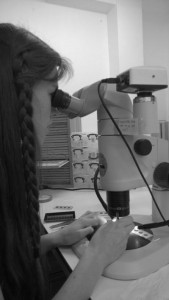Over the summer I completed a four-week Nuffield Research Placement at the Open University in the Environment, Earth and Ecosystems Department. My project was on how optimum growth conditions affect the calcification of planktonic foraminifera.
In other words, I was interested in surface-dwelling plankton. When conditions are ‘optimum’, these creatures grow in large numbers. But does this increase in numbers affect how surface-dwelling plankton build their shells, and if so, why? Answering this question will give us a better understanding of their ecology and how they will respond in the future to environmental changes.
I studied a species of foraminifera called Globortalia inflata to investigate how the thickness of their shells has changed over the past 20,000 years and then compared my results with published data on the abundance of G inflata (a measure of optimum growth conditions).

